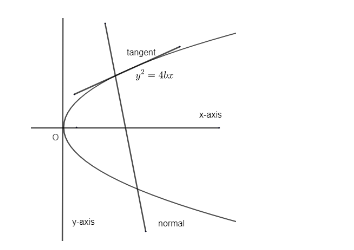
Answer
471.3k+ views
Hint: o solve this question we will first of all determine the equation of normal of given parabola. The equation of normal of parabola of type, \[{{y}^{2}}=4ax\] ar point \[\left( {{x}_{1}},{{y}_{1}} \right)\] is given by,
\[\left( y-{{y}_{1}} \right)=\dfrac{-1}{\dfrac{dy}{dx}}\left( x-{{x}_{1}} \right)\]
Complete step-by-step answer:
Given parabola is, \[{{y}^{2}}=4bx\] this parabola and normal would be of the form.

We have equation of normal of parabola, \[{{y}^{2}}=4ax\] is, \[\left( y-{{y}_{1}} \right)=\dfrac{-1}{\left( \dfrac{dy}{dx} \right)}\left( x-{{x}_{1}} \right)\] at point \[\left( {{x}_{1}},{{y}_{1}} \right)\] - (1)
Given that equation of parabola is, \[{{y}^{2}}=4bx\].
Differentiating both sides with respect to x we get,
\[\begin{align}
& 2y\dfrac{dy}{dx}=4b \\
& \Rightarrow \dfrac{dy}{dx}=\dfrac{4b}{2y} \\
\end{align}\]
Then, \[\dfrac{dy}{dx}=\dfrac{2b}{y}\] - (2)
We are given that the normal is at the point \[\left( bt_{1}^{2},2b{{t}_{1}} \right)\].
Substituting value of \[y=2b{{t}_{1}}\] in equation (2) we get,
\[\Rightarrow \dfrac{dy}{dx}=\dfrac{1\left( 2b \right)}{2b{{t}_{1}}}=\dfrac{1}{{{t}_{1}}}\]
Also the slope of normal is \[\dfrac{-1}{\left( \dfrac{dy}{dx} \right)}\].
\[\Rightarrow \] Slope of normal = \[\dfrac{-1}{\left( \dfrac{1}{{{t}_{1}}} \right)}=-{{t}_{1}}\].
Therefore, equation of normal ar \[\left( bt_{1}^{2},2b{{t}_{1}} \right)\] is,
\[\Rightarrow \left( y-2b{{t}_{1}} \right)=-{{t}_{1}}\left( x-bt_{1}^{2} \right)\] - (3)
Now the point \[\left( bt_{2}^{2},2b{{t}_{2}} \right)\] also lies on the normal. Therefore, point \[\left( bt_{2}^{2},2b{{t}_{2}} \right)\] satisfies (3) we get,
\[\Rightarrow \left( 2b{{t}_{2}}-2b{{t}_{1}} \right)=-{{t}_{1}}\left( bt_{2}^{2}-bt_{1}^{2} \right)\]
Taking 2b common on left we get, and also taking b common on right;
\[\Rightarrow 2b\left( {{t}_{2}}-{{t}_{1}} \right)=-{{t}_{1}}b\left( t_{2}^{2}-t_{1}^{2} \right)\]
Now applying identity \[\left( {{a}_{2}}-{{a}_{1}} \right)\left( {{a}_{2}}+{{a}_{1}} \right)=a_{2}^{2}-a_{1}^{2}\] on the RHS of above equation we get,
\[\Rightarrow 2b\left( {{t}_{2}}-{{t}_{1}} \right)=-{{t}_{1}}b\left( {{t}_{2}}-{{t}_{1}} \right)\left( {{t}_{2}}+{{t}_{1}} \right)\]
Now cancelling \[b\left( {{t}_{2}}-{{t}_{1}} \right)\] on both sides we get,
This can be done as \[b\ne 0\] & \[{{t}_{2}}-{{t}_{1}}\ne 0\].
\[\begin{align}
& \Rightarrow 2=-{{t}_{1}}\left( {{t}_{2}}+{{t}_{1}} \right) \\
& \Rightarrow -{{t}_{1}}\left( {{t}_{2}}+{{t}_{1}} \right)=2 \\
& \Rightarrow -{{t}_{2}}{{t}_{1}}=2+t_{1}^{2} \\
\end{align}\]
Dividing by \[{{t}_{1}}\] we get,
\[\Rightarrow -{{t}_{2}}=\dfrac{2+t_{1}^{2}}{{{t}_{1}}}\]
Multiplying ‘minus’ both sides we get,
\[\Rightarrow {{t}_{2}}=-\dfrac{2}{{{t}_{1}}}-{{t}_{1}}\]
\[\Rightarrow {{t}_{2}}=-{{t}_{1}}-\dfrac{2}{{{t}_{1}}}\], which is option (b).
So, the correct answer is “Option B”.
Note: The possibility of error in this question can be at a point where students directly substitute value of point \[\left( bt_{2}^{2},2b{{t}_{2}} \right)\] in equation of parabola. This would be wrong because this point \[\left( bt_{2}^{2},2b{{t}_{2}} \right)\] is a point of contact normal of parabola. So, we first need to determine the parabola normal of parabola then we can proceed accordingly.
\[\left( y-{{y}_{1}} \right)=\dfrac{-1}{\dfrac{dy}{dx}}\left( x-{{x}_{1}} \right)\]
Complete step-by-step answer:
Given parabola is, \[{{y}^{2}}=4bx\] this parabola and normal would be of the form.

We have equation of normal of parabola, \[{{y}^{2}}=4ax\] is, \[\left( y-{{y}_{1}} \right)=\dfrac{-1}{\left( \dfrac{dy}{dx} \right)}\left( x-{{x}_{1}} \right)\] at point \[\left( {{x}_{1}},{{y}_{1}} \right)\] - (1)
Given that equation of parabola is, \[{{y}^{2}}=4bx\].
Differentiating both sides with respect to x we get,
\[\begin{align}
& 2y\dfrac{dy}{dx}=4b \\
& \Rightarrow \dfrac{dy}{dx}=\dfrac{4b}{2y} \\
\end{align}\]
Then, \[\dfrac{dy}{dx}=\dfrac{2b}{y}\] - (2)
We are given that the normal is at the point \[\left( bt_{1}^{2},2b{{t}_{1}} \right)\].
Substituting value of \[y=2b{{t}_{1}}\] in equation (2) we get,
\[\Rightarrow \dfrac{dy}{dx}=\dfrac{1\left( 2b \right)}{2b{{t}_{1}}}=\dfrac{1}{{{t}_{1}}}\]
Also the slope of normal is \[\dfrac{-1}{\left( \dfrac{dy}{dx} \right)}\].
\[\Rightarrow \] Slope of normal = \[\dfrac{-1}{\left( \dfrac{1}{{{t}_{1}}} \right)}=-{{t}_{1}}\].
Therefore, equation of normal ar \[\left( bt_{1}^{2},2b{{t}_{1}} \right)\] is,
\[\Rightarrow \left( y-2b{{t}_{1}} \right)=-{{t}_{1}}\left( x-bt_{1}^{2} \right)\] - (3)
Now the point \[\left( bt_{2}^{2},2b{{t}_{2}} \right)\] also lies on the normal. Therefore, point \[\left( bt_{2}^{2},2b{{t}_{2}} \right)\] satisfies (3) we get,
\[\Rightarrow \left( 2b{{t}_{2}}-2b{{t}_{1}} \right)=-{{t}_{1}}\left( bt_{2}^{2}-bt_{1}^{2} \right)\]
Taking 2b common on left we get, and also taking b common on right;
\[\Rightarrow 2b\left( {{t}_{2}}-{{t}_{1}} \right)=-{{t}_{1}}b\left( t_{2}^{2}-t_{1}^{2} \right)\]
Now applying identity \[\left( {{a}_{2}}-{{a}_{1}} \right)\left( {{a}_{2}}+{{a}_{1}} \right)=a_{2}^{2}-a_{1}^{2}\] on the RHS of above equation we get,
\[\Rightarrow 2b\left( {{t}_{2}}-{{t}_{1}} \right)=-{{t}_{1}}b\left( {{t}_{2}}-{{t}_{1}} \right)\left( {{t}_{2}}+{{t}_{1}} \right)\]
Now cancelling \[b\left( {{t}_{2}}-{{t}_{1}} \right)\] on both sides we get,
This can be done as \[b\ne 0\] & \[{{t}_{2}}-{{t}_{1}}\ne 0\].
\[\begin{align}
& \Rightarrow 2=-{{t}_{1}}\left( {{t}_{2}}+{{t}_{1}} \right) \\
& \Rightarrow -{{t}_{1}}\left( {{t}_{2}}+{{t}_{1}} \right)=2 \\
& \Rightarrow -{{t}_{2}}{{t}_{1}}=2+t_{1}^{2} \\
\end{align}\]
Dividing by \[{{t}_{1}}\] we get,
\[\Rightarrow -{{t}_{2}}=\dfrac{2+t_{1}^{2}}{{{t}_{1}}}\]
Multiplying ‘minus’ both sides we get,
\[\Rightarrow {{t}_{2}}=-\dfrac{2}{{{t}_{1}}}-{{t}_{1}}\]
\[\Rightarrow {{t}_{2}}=-{{t}_{1}}-\dfrac{2}{{{t}_{1}}}\], which is option (b).
So, the correct answer is “Option B”.
Note: The possibility of error in this question can be at a point where students directly substitute value of point \[\left( bt_{2}^{2},2b{{t}_{2}} \right)\] in equation of parabola. This would be wrong because this point \[\left( bt_{2}^{2},2b{{t}_{2}} \right)\] is a point of contact normal of parabola. So, we first need to determine the parabola normal of parabola then we can proceed accordingly.
Recently Updated Pages
Fill in the blanks with suitable prepositions Break class 10 english CBSE

Fill in the blanks with suitable articles Tribune is class 10 english CBSE

Rearrange the following words and phrases to form a class 10 english CBSE

Select the opposite of the given word Permit aGive class 10 english CBSE

Fill in the blank with the most appropriate option class 10 english CBSE

Some places have oneline notices Which option is a class 10 english CBSE

Trending doubts
Fill the blanks with the suitable prepositions 1 The class 9 english CBSE

How do you graph the function fx 4x class 9 maths CBSE

When was Karauli Praja Mandal established 11934 21936 class 10 social science CBSE

Which are the Top 10 Largest Countries of the World?

What is the definite integral of zero a constant b class 12 maths CBSE

Why is steel more elastic than rubber class 11 physics CBSE

Distinguish between the following Ferrous and nonferrous class 9 social science CBSE

The Equation xxx + 2 is Satisfied when x is Equal to Class 10 Maths

Differentiate between homogeneous and heterogeneous class 12 chemistry CBSE




